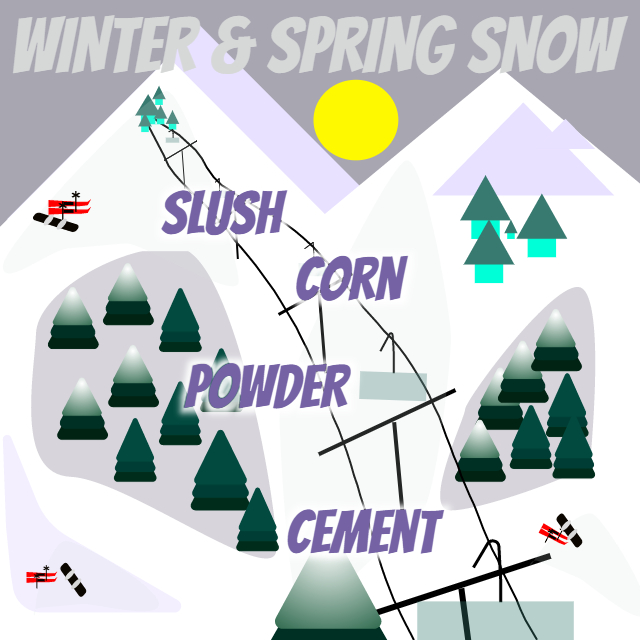PORTLAND, Ore. (KOIN) – The Pacific Northwest is known for some amazing skiing and snowboarding. We have volcanoes to shred up. Well, have you noticed the difference between the snow from the winter to the spring?
Are you part of a family that is always on the hunt for fresh powder? Do you hang up the skis when spring comes in because it’s just not the same?
Today we are going to discuss the difference between snow type and what it means for your mountain fun.
WATCH THE VIDEO BELOW

Doesn’t that video get you thinking about snow?! Getting up to the mountain to hit the slopes sounds fun.
Depending on the time of the year, the snow may feel different on your skis or snowboard. The obvious cause; weather conditions change from winter to spring. Temperature and sunshine affect how snow looks and feels. We will get to that after you check out some of the terms below.
MOUNTAIN VERNACULAR

WINTER SNOW
What most are craving on the mountain is something called powder. This is the fresh snow that comes after a winter storm that is fine and well, powdery. This is the type of snow that comes from cold winter temperatures that produce tiny snowflakes that don’t stick together. Think of the snow that doesn’t do a good job coming together for snowballs. This type of snow tends to fall east of the Cascades, but we have our moments.

A familiar phrase around here is something called Cascade concrete/cement. This type of snow is common around the Cascades because we tend to have high volume snow but it consists of a lot of moisture. When you’re riding this snow in the winter, it can offer more grip but it may be slower. This is snow that forms closer to freezing. You can pack this snow and it will offer more layering than your powdery snow that you can slice through.
SPRING SNOW
When spring comes along, that means more sunshine and warmer temperatures. Some spring storms bring rain to the mountain near the base of the ski resorts. You can imagine, that this is going to change the type of skiing and boarding.

You may find that the snow is a bit slushy in the spring. This is the snow that will really slow you down and the grip will hold you down. This happens in the spring when the snow is exposed to warm temperatures and that mighty sun in the sky. It is still enjoyable to ski and board, but it won’t feel like that winter snow.
You may also hear the term corn, which if you’re from the Midwest like me, it will strike another image in your head. This is the spring skiing snow that folks typically enjoy over something that is more slushy. This is snow that happens when the snow starts to goes through a freeze-melt cycle. Ultimately the snow will melt and then freeze again and it will look like corn. It won’t slow you down as much as a slushy spring snow, but it doesn’t offer the same speed as you would be striving for in the winter. For those of you that just enjoy cruising, this is still a blast.
WHAT’S GOING ON?
Whether snow is wet or dry all depends on the amount of water that is present. We call this the snow to liquid equivalent in meteorology. This is essentially the amount of water that is melted down from that big pile of snow. The most common snow to liquid equivalent is 10:1. That is saying that 10 inches of snow will melt down to 1 inch of liquid precipitation in a rain gauge. Wet snowflakes tend to stick together, creating larger snowflakes. This is typically the case as the surface temperatures are closer to freezing and the temperatures aloft are near freezing or potentially just above allowing for melting. During a real wet snow, the equivalent may be closer to 5:1.

As we mentioned above, that powdery snow is fine and is typically a small snowflake. This is the opposite of what occurs in a wet snow situation. Temperatures are typically below freezing, by some margin, from the troposphere down to the surface. In some cases, the snow to liquid equivalent can be something like 30:1 in these cases. You tend to find these cases in the Rockies up in Canada.
Now you know some of the terms that you can use up on the mountain!